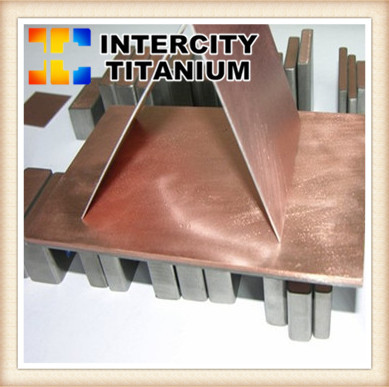Titanium-copper composite materials introduced
The current titanium composite materials have many types, such as titanium steel clad plate, titanium clad copper rod, titanium and titanium titanium transition joints, titanium composite materials not only meet the needs of users, and the price is lower than pure titanium or alloy, Welcomed by the mall. Such as titanium steel composite plate, not only gets the strength of steel, but also has the corrosion resistance of titanium, widely used in metallurgy and chemical equipment production.
Titanium copper composite rod is commonly known as titanium copper rod. The metal anode of the cell is supported by the titanium copper composite rod, which has three functions: one is intended to support the anode, the other is to conduct electricity, and the other is to resist corrosion. In order to meet these demands, the corrosion resistance of titanium and the conductivity of copper are used to link the two together. The middle of the composite bar is copper, outsourcing a layer of titanium, cross-section square and palace lantern two completely satisfied with the use of demand. Titanium copper composite billet under strong pressure during the extrusion process, the two metal interfaces constitute a metallurgical contact, the waveform interface is the best way to contact the two metals, and then enhance the contact reliability of titanium copper composite rod, the resistivity Small, conductive good. Foreign developed a titanium-copper composite pipe, titanium inside the titanium, the advantage is saving copper, corrosion function.
Explosion welding transition joints with high contact strength and low contact resistance of the interface, utilized in the industrial sector to enhance production, improve efficiency and save energy. Currently developed titanium, titanium stainless steel, titanium steel, aluminum stainless steel, aluminum titanium stainless steel, aluminum and copper and other transition joints. Metallic adapters, whether plate-shaped or tubular, can be obtained from suitably dimensional flat pieces, but usually used in stressed, hot-shock and high-current parts, it requires a high degree of contact strength and excellent the conductive function. Selection of improved flat-panel blasting composite technology can be achieved with high contact strength, low interfacial resistance of a variety of bimetal and three metal transition joints.









